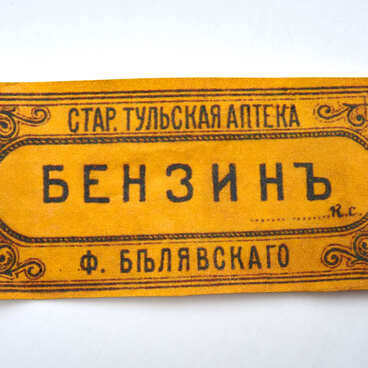Corrosive sublimate is mercury chloride, a poisonous white powder. The bandages with corrosive sublimate presented in the exhibition were made in the American company ‘Bauer and Black’ in 1917. Such bandages could be found in a military doctor’s belt kit among other medicines and medical instruments. They were kept in a cardboard box, which was covered with a layer of paraffin. The paraffin protected the contents from moisture. Each package contained two bandages 50 cm long. It was the dressing material that was used in the most severe cases of injury during the First World War.
The word ‘bandage’ comes from the German binde — ‘bandage’. In ancient Egypt, healers used clean strips of bleached canvas soaked in medicinal compositions, including honey, oils, wine, and resins obtained from frankincense and myrrh, to treat wounds. Hippocrates recommended using a cloth that easily absorbs liquid, as a dressing material. In ancient Rome, thin plates made of various metals and alloys were used for dressing wounds, but with the obligatory presence of copper in the composition. The Romans believed that copper stops the blood. Medieval doctors made bandages with almond and olive juice, turpentine, herbal infusions for better healing. They also used lard, freshly removed skin, cobwebs, urine, and animal droppings.
In the 18th century, doctors noticed that, unlike dense fabrics, light cotton fabrics absorbed liquids faster. So thin and expensive ‘bandages’ came into use. Gauze, from which modern bandages are made, appeared at the end of the 18th century. Gauze is called ‘marlya’ in Russian — the name comes from the French ‘marli’, which means ‘muslin’ — a thin airy fabric. Initially, the gauze served only as a bed-curtain. But soon doctors appreciated its absorbent properties. By the middle of the 19th century, a Russian military surgeon Nikolai Pirogov began using bandages soaked in a solution of phenylic acid according to the method of the English surgeon Joseph Lister.
The bandages presented in the exhibition are soaked in toxic poison. For a long time, drugs made based on mercury were not considered dangerous for people. It was added to ointments for various skin diseases treatment. In the late 19th — early 20th centuries, it was considered an indispensable tool for the treatment of syphilis. Doctors also offered their patients steam baths: inhaling mercury vapor was considered the best way to treat it. In Russia, mercury-based medicines were actively used in homeopathy for the treatment of eye diseases, diseases of the digestive tract, and tumors. Mercury-based drugs were given to babies as an analgesic for teething.



